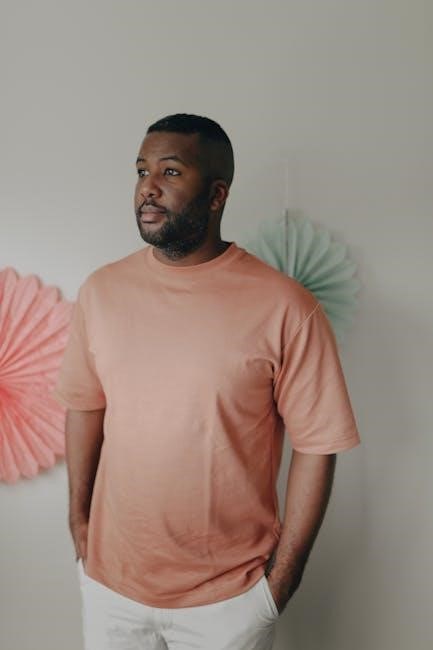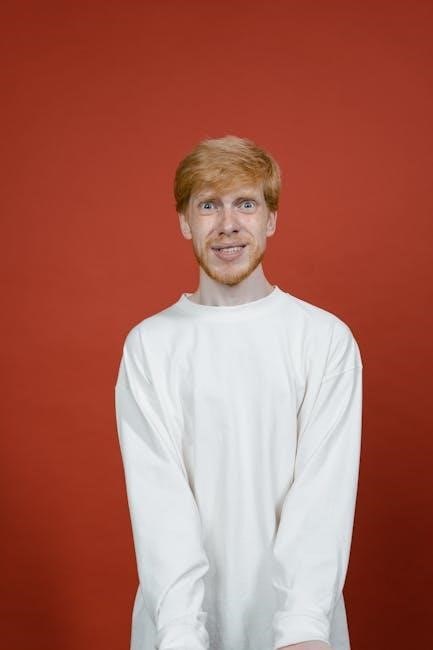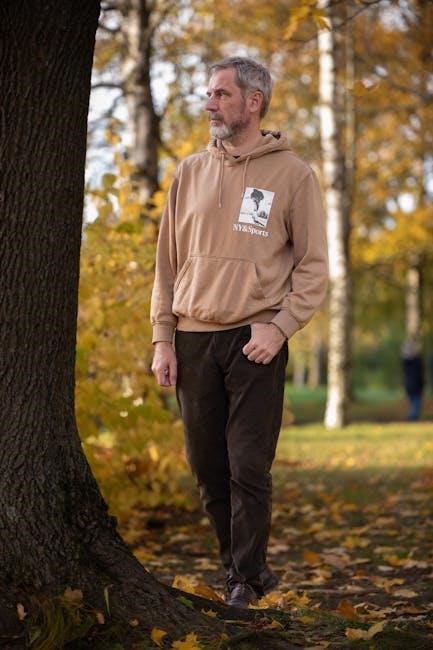beard length guide
Discover the perfect beard length with expert tips and guides․ Learn how to choose a style that flatters your face shape, maintains ease, and suits your personality seamlessly always․
The Evolution of Beard Styles Over Time
Beard styles have transformed significantly over centuries, reflecting cultural and societal trends․ In ancient times, long beards symbolized wisdom and status, while in the Middle Ages, shorter, neatly trimmed beards were favored․ The 19th century saw a rise in handlebar and chevron styles, often associated with sophistication․ By the early 20th century, clean-shaven faces dominated, with beards making a comeback in the 1960s as a symbol of counterculture․ Today, beard lengths vary widely, from stubble to full beards, with trends leaning toward shorter, more manageable styles․ The modern era emphasizes personal expression, with tools like beard trimmers enabling precise control․ Whether it’s a 10mm short beard or a longer, wizard-like style, the evolution of beard lengths highlights how facial hair reflects individuality and cultural shifts over time․
Importance of Choosing the Right Beard Length
Selecting the right beard length is crucial for enhancing your appearance and confidence․ A well-chosen length complements your face shape, balancing proportions and highlighting your best features․ For instance, shorter beards like stubble or 10mm styles can create a youthful, tidy look, while longer beards may add a sense of maturity․ Proper beard length also affects maintenance; shorter styles are easier to manage, while longer ones require more care․ Additionally, the right length aligns with personal style and lifestyle, ensuring practicality․ Experts emphasize that a beard length chart and trimmer guard settings, such as guards 1-4 (1․6mm to 13mm), can help achieve a professional look․ Ultimately, the ideal length enhances your aesthetic, making it a key element of grooming that shouldn’t be overlooked․

Understanding Different Beard Lengths
From stubble to full beards, understanding various lengths helps you find the perfect style․ Learn about measurements, maintenance, and how each length enhances your unique look and personality․

Defining Beard Length: From Stubble to Full Beard
Beard length varies significantly, ranging from a short stubble to a full, flowing beard․ Stubble, typically 1-5mm, offers a rugged, low-maintenance look․ A short beard, around 5-10mm, frames the jawline neatly․ Medium lengths, between 10-20mm, provide versatility, while long beards, exceeding 20mm, make a bold statement․ Each length complements different face shapes and personal styles․ Understanding these categories helps in choosing a beard that enhances your features․ Proper care and styling are essential for maintaining a clean, polished appearance․ Whether you prefer a subtle trim or a majestic mane, defining your beard length is the first step to achieving your ideal look․ This guide explores these options in detail, ensuring you find the perfect fit for your lifestyle and aesthetic preferences․

Beard Length Chart: Measurements and Descriptions
A beard length chart categorizes growth into distinct stages, each defined by specific measurements․ Stubble typically ranges from 1-5mm, offering a subtle, textured appearance․ A short beard measures 5-10mm, creating a defined yet neat look․ Medium beards span 10-20mm, providing a balanced and versatile style․ Full beards exceed 20mm, showcasing a robust and mature aesthetic․ Each length serves a unique purpose, catering to individual preferences and face shapes․ This chart helps men understand the progression of beard growth and choose a length that suits their lifestyle and personal style․ By measuring accurately, individuals can achieve their desired look with precision and confidence․

Choosing the Right Beard Length for Your Face Shape
Beard length enhances facial symmetry by balancing proportions․ Oval faces suit most lengths, while round faces benefit from longer styles to elongate․ Square faces look best with shorter, softer beards, and triangular faces with fuller chins prefer shorter lengths to avoid emphasizing the jawline․ Understanding face shape helps select a flattering beard length that complements natural features, ensuring a harmonious and stylish appearance․ Properly chosen lengths create balance and highlight one’s best facial attributes effectively․ This approach ensures personal style aligns with individual aesthetics seamlessly․ Always consider face shape when deciding beard length to achieve the most flattering look possible․ Precision is key for optimal results․
How to Determine Your Face Shape
Determining your face shape is crucial for selecting a beard length that complements your features․ Start by measuring your face accurately․ Use a flexible tape measure or a string to measure across your cheekbones, from one temple to the other․ Next, measure your jawline by tracing from the tip of your chin to just below your earlobe on both sides and adding the two measurements together․ Finally, measure the length of your face from the center of your hairline to the bottom of your chin․ Compare these measurements to identify your face shape:

- Oval: Forehead and jawline are similar, with a slightly longer face length․
- Round: Cheekbones are the widest measurement, with equal forehead, cheekbones, and jawline․
- Square: Forehead, cheekbones, and jawline are nearly equal, with sharp angles․
- Triangular: Narrow forehead and temples, with a wider jawline․
- Heart-Shaped: Broad forehead and temples, with a narrow chin and jawline․
By understanding your face shape, you can choose a beard length that balances your features and enhances your appearance․

Beard Length Recommendations for Each Face Shape
Choosing the right beard length for your face shape ensures a balanced and flattering look․ For oval faces, any beard length works well, as the face is naturally proportionate․ Round faces benefit from longer beards (1–2 inches) to elongate the appearance․ Square faces should opt for shorter lengths (0․5–1 inch) to soften sharp angles․ Triangular faces look best with shorter beards on the chin and longer on the sides to balance the jawline․ For heart-shaped faces, shorter beards with a trimmed chin draw attention downward, slimming the forehead․ By matching your beard length to your face shape, you create harmony and enhance your natural features․
Styling Options for Different Beard Lengths
Each beard length offers unique styling possibilities․ For stubble, maintaining a neat, defined edge creates a sleek look․ Short beards (0․5–1 inch) can be trimmed to frame the jawline or styled with a slight taper․ Medium beards (1–3 inches) allow for more versatility, such as a Van Dyke or Chevron style․ Long beards (over 3 inches) can be braided, tied with a beard band, or left natural for a rugged appearance․ Regardless of length, using a trimmer for precision and beard oil for softness enhances any style․ Regular grooming ensures your beard looks polished and complements your face shape․ Experiment with different techniques to find the style that best suits your personality and lifestyle․

Maintenance and Care for Different Beard Lengths
Proper grooming is essential for all beard lengths․ Regular trimming, washing, and conditioning keep your beard healthy and neat, while preventing itchiness and dandruff․
Daily Maintenance Routine for Short and Long Beards
A consistent daily routine is vital for maintaining a healthy and stylish beard, regardless of its length․ For short beards, start with regular trimming to keep the edges defined and neat․ Use a trimmer with a short guard size to maintain uniformity․ Wash your beard 2-3 times a week with a mild shampoo, followed by a conditioner to soften the hairs and prevent itchiness․ For long beards, incorporate a daily brushing routine to detangle and distribute natural oils evenly․ Wash the beard 1-2 times a week to avoid stripping it of its natural oils․ Regularly trim split ends and stray hairs to maintain shape․ Apply beard oil or balm daily to keep the beard moisturized and shiny․ Consistency in your routine will ensure your beard remains healthy, tidy, and visually appealing at any length․
Best Products for Beard Care at Every Length
Choosing the right products is essential for maintaining a healthy and well-groomed beard at any length․ For shorter beards, beard oil is a must to keep the hair soft and moisturized, while also preventing itchiness․ Beard balm is ideal for styling and taming stray hairs, especially for medium-length beards․ For longer beards, beard wax provides extra hold and helps shape the beard․ A good beard shampoo and conditioner are necessary for all lengths to keep the hair clean and hydrated․ Additionally, a detangling brush is perfect for longer beards to prevent knots and distribute oils evenly․ Using high-quality products tailored to your beard length ensures it stays healthy, manageable, and visually appealing․ Invest in a trimmer for touch-ups and a comb for precise styling to complete your beard care routine․

How to Measure and Achieve the Perfect Beard Length
To measure and achieve the perfect beard length, use a ruler or calipers for accuracy․ Regular trimming with a trimmer and appropriate guard sizes helps maintain uniformity․ Consider face shape for flattering styles, and use styling products like oils and balms to keep your beard healthy and groomed․ Watching tutorials can help avoid common trimming mistakes, ensuring a polished look that complements your features․
Tools and Techniques for Measuring Beard Length
Measuring beard length accurately requires the right tools and techniques․ A ruler or digital calipers are essential for precise measurements․ Use a beard comb to detangle and align hairs before measuring․ Start at the chin and measure across the jawline․ For longer beards, section the beard and measure from the bottom of the chin to the tip․ A mirror helps ensure accuracy․ Combining measurements with visual checks ensures consistency․ Track growth over time to maintain desired lengths․ Regular trimming with adjustable guards on trimmers helps achieve uniformity․ Always measure on clean, dry hair for the most accurate results․ This approach ensures a well-groomed and precise beard length tailored to your style․
How to Use a Beard Trimmer Effectively
Using a beard trimmer effectively involves a combination of technique and preparation․ Start by selecting the appropriate guard size based on your desired beard length․ Always trim on clean, dry hair for better control and even results․ Work in small sections, starting from the neck and moving upward․ Use steady, smooth strokes, following the grain to avoid irritation․ For tighter lines, trim without the guard, but be cautious near sensitive areas․ Regularly clean the trimmer blades and lubricate them with oil to maintain performance․ Store the trimmer in a dry place to prevent rust․ By following these steps, you can achieve a precise, well-groomed beard that aligns with your style preferences․
Common Mistakes to Avoid When Growing and Trimming
Common mistakes include over-trimming, neglecting neckline maintenance, and growing uneven patches․ Avoid cutting too much at once and ensure patience during the growth phase for a balanced look․
Trimming Errors That Can Ruin Your Beard
One of the most common trimming errors is cutting too aggressively, leading to uneven patches or a lopsided appearance․ Many individuals mistakenly trim without a clear plan, resulting in an asymmetrical beard․ Another error is trimming too close to the skin, which can cause irritation and ingrown hairs․ Using dull or unaligned trimmers can also create jagged edges and an unkempt look․ Additionally, trimming wet hair can lead to inaccurate measurements, as hair shrinks when dry․ Over-trimming the neckline is another frequent mistake, disrupting the natural flow of the beard․ To avoid these errors, use sharp tools, trim dry hair, and follow a steady, methodical approach․ Regular practice and patience are key to mastering the art of trimming without ruining your beard’s potential․
How to Avoid Patchiness at Different Lengths
Avoiding patchiness in your beard requires careful attention to growth patterns and maintenance․ For shorter lengths, focus on trimming evenly to create the illusion of density․ Use a trimmer with a guard to maintain uniformity, and avoid over-trimming sparse areas, as this can accentuate patches․ For longer beards, embrace natural growth patterns and resist the urge to fill in gaps artificially․ Instead, use beard oils and balms to keep hair healthy and promote even growth․ Strategic styling, such as braiding or combing, can also help distract from patchy areas․ If genetic factors cause persistent patchiness, consider allowing the beard to grow longer, as it often becomes fuller over time․ Patience and consistent care are key to achieving a balanced, cohesive look at any length․

Popular Beard Length Trends
Popular beard length trends emphasize versatility, with short and medium lengths offering a polished look, while stubble provides a stylish, low-maintenance option․ Long beards remain trendy, showcasing natural texture and rugged charm․
Current Trends in Beard Length and Style
Current beard trends highlight a mix of short, medium, and long lengths, catering to diverse preferences․ Short beards, such as the 1-2 mm stubble, remain popular for their sleek, modern look․ Medium-length beards, like the “corporate beard,” are favored for their professional yet stylish appeal․ Long beards continue to trend, with many embracing natural, flowing styles or neatly braided designs․ The emphasis is on versatility, allowing individuals to express their personality through their beard; Tools like beard trimmers and styling products are essential for maintaining these looks․ Additionally, the rise of beard care routines has led to healthier, more groomed beards across all lengths․ Whether it’s a tidy stubble or a flowing mane, current trends celebrate both practicality and self-expression․
How to Adapt Trends to Your Personal Style
Adapting beard trends to your personal style involves balancing current fashion with what suits your face shape, lifestyle, and preferences․ Start by identifying your face shape to determine flattering lengths and styles․ For instance, round faces benefit from longer, angular beards, while square faces look best with softer, shorter styles․ Consider your lifestyle too—busy schedules may favor low-maintenance stubble or short beards, while those with more time can manage longer, styled looks․ Personalize trends by adding unique touches, like a slight asymmetry or a hint of color․ Confidence is key, so choose a style that makes you feel authentic․ Experiment with lengths and shapes to find what complements your features and reflects your personality․ Remember, trends are a guide, but your beard should be a reflection of you․


